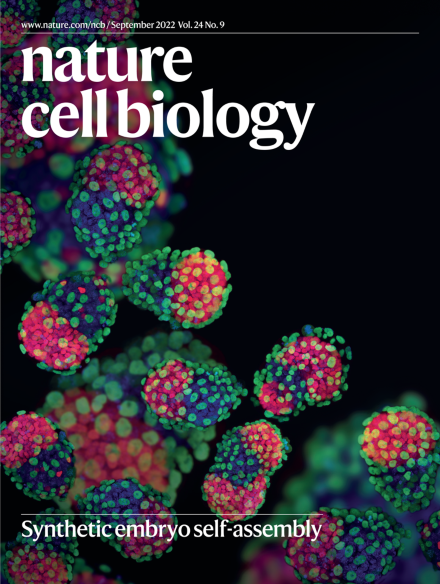微管结构将AMOT稳定性与YAP/TAZ机械转导和Hippo信号传导联系起来。
IF 19.1
1区 生物学
Q1 CELL BIOLOGY
引用次数: 0
摘要
细胞机械转导是一个关键的信息系统,但其机制仍然是难以捉摸的。在这里,我们揭示了微管在机械信号传导中的作用,在亚核f -肌动蛋白和核包膜力学的下游操作。机械激活后,微管从核周笼重新排列成由中心体构成的径向阵列。这种结构重排触发AMOT蛋白的降解,我们认为AMOT蛋白是细胞质中隔离YAP/TAZ的关键机械变阻器。AMOT在机械- off状态下是稳定的,但在机械- on细胞状态下会降解,微管允许AMOT与动力蛋白/动力蛋白复合物快速运输到核周围体蛋白酶体。这一过程确保了YAP/TAZ功能在响应细胞力学变化时的快速控制,实验中AMOT蛋白的缺失使细胞对力学调节不敏感。Ras/RTK癌基因通过破坏这种以amot为中心的机械检查点来促进YAP/ taz依赖性肿瘤的发生。值得注意的是,Hippo通路对机械转导进行微调:LATS激酶使AMOT磷酸化,使其免于降解,从而间接抑制YAP/TAZ。因此,AMOT蛋白的稳定性是连接细胞骨架重组和Hippo信号传导到YAP/TAZ机械信号传导的枢纽。本文章由计算机程序翻译,如有差异,请以英文原文为准。

Microtubule architecture connects AMOT stability to YAP/TAZ mechanotransduction and Hippo signalling
Cellular mechanotransduction is a key informational system, yet its mechanisms remain elusive. Here we unveil the role of microtubules in mechanosignalling, operating downstream of subnuclear F-actin and nuclear envelope mechanics. Upon mechanical activation, microtubules reorganize from a perinuclear cage into a radial array nucleated by centrosomes. This structural rearrangement triggers degradation of AMOT proteins, which we identify as key mechanical rheostats that sequester YAP/TAZ in the cytoplasm. AMOT is stable in mechano-OFF but degraded in mechano-ON cell states, where microtubules allow AMOT rapid transport to the pericentrosomal proteasome in complex with dynein/dynactin. This process ensures swift control of YAP/TAZ function in response to changes in cell mechanics, with experimental loss of AMOT proteins rendering cells insensitive to mechanical modulations. Ras/RTK oncogenes promote YAP/TAZ-dependent tumorigenesis by corrupting this AMOT-centred mechanical checkpoint. Notably, the Hippo pathway fine-tunes mechanotransduction: LATS kinases phosphorylate AMOT, shielding it from degradation, thereby indirectly restraining YAP/TAZ. Thus, AMOT protein stability serves as a hub linking cytoskeletal reorganization and Hippo signalling to YAP/TAZ mechanosignalling. Vanni et al. show a role for microtubules in YAP/TAZ mechanosignalling. Mechanoresponsive microtubule reorganization into centrosomal arrays allows for AMOT delivery to pericentrosomal proteasomes and degradation, leading to YAP/TAZ activation.
求助全文
通过发布文献求助,成功后即可免费获取论文全文。
去求助
来源期刊

Nature Cell Biology
生物-细胞生物学
CiteScore
28.40
自引率
0.90%
发文量
219
审稿时长
3 months
期刊介绍:
Nature Cell Biology, a prestigious journal, upholds a commitment to publishing papers of the highest quality across all areas of cell biology, with a particular focus on elucidating mechanisms underlying fundamental cell biological processes. The journal's broad scope encompasses various areas of interest, including but not limited to:
-Autophagy
-Cancer biology
-Cell adhesion and migration
-Cell cycle and growth
-Cell death
-Chromatin and epigenetics
-Cytoskeletal dynamics
-Developmental biology
-DNA replication and repair
-Mechanisms of human disease
-Mechanobiology
-Membrane traffic and dynamics
-Metabolism
-Nuclear organization and dynamics
-Organelle biology
-Proteolysis and quality control
-RNA biology
-Signal transduction
-Stem cell biology
 求助内容:
求助内容: 应助结果提醒方式:
应助结果提醒方式:


